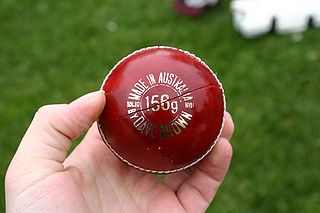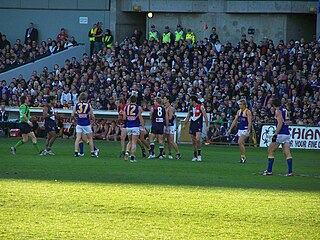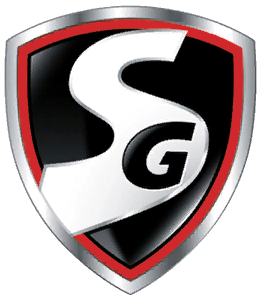
The West Australian Football League is an Australian rules football league based in Perth, Western Australia. The league currently consists of ten teams, which play each other in a 20-round season usually lasting from April to September, with the top five teams playing off in a finals series, culminating in a Grand Final. The league also runs reserves, colts (under-19) and women's competitions.

A cricket ball is a hard, solid ball used to play cricket. A cricket ball consists of a cork core wound with string then a leather cover stitched on, and manufacture is regulated by cricket law at first-class level. The trajectory of a cricket ball when bowled, through movement in the air, and off the ground, is influenced by the action of the bowler and the condition of the ball and the pitch, while working on the cricket ball to obtain optimal condition is a key role of the fielding side. The principal method through which the batter scores runs is by hitting the ball, with the bat, into a position where it would be safe to take a run, or by directing the ball through or over the boundary. Cricket balls are harder and heavier than baseballs.

Sherrin is a brand of football used in Australian rules football and is the official ball of the Australian Football League, designed to its official specifications. It was the first ball designed specifically for the sport.

Australian rules football in Western Australia (WA) is the most popular sport in the state. It is governed by the West Australian Football Commission (WAFC).

Kookaburra is an Australian sports equipment and apparel company based in Melbourne, Australia. The company was founded in 1890 and specializes in manufacturing various equipment used for Australian rules football, cricket, and field hockey. The company is named after the Australian bird Kookaburra. The company manufactures the white ball used in all One-day international matches and the red ball used in Test cricket in Australia, New Zealand, South Africa, Pakistan, Sri Lanka, Bangladesh, and Zimbabwe.
Mitre Sports International Ltd., mostly known as Mitre, is an English sports equipment manufacturer based in Wakefield. Mitre is mainly focused on association football but also providing equipment for other sports. Having founded in 1817 in Huddersfield, the company is one of the oldest of its type in the world. Mitre is currently a subsidiary of the British family–owned Pentland Group.

Rushton Park is an Australian rules football ground located in Mandurah, Western Australia. Having been in use as a football ground since the early 1960s, the ground is currently used as a home ground by three clubs: the Peel Thunder, competing in the West Australian Football League (WAFL), the Mandurah Mustangs, competing in the Peel Football League (PFL), and the Peel Thunderbirds, competing in the West Australian Women's Football League (WAWFL). Rushton Park is the only regularly-used ground in the WAFL that falls outside the Perth metropolitan area.

East Fremantle Oval is an Australian rules football ground located in East Fremantle, Western Australia. The ground was opened in 1906, and underwent a large redevelopment in 1953. It current serves as the home ground of the East Fremantle Football Club in the West Australian Football League (WAFL). East Fremantle Oval has a capacity of around 20,000 people, but has hosted in excess of this number previously, with a record crowd of 21,317 for a match between East Fremantle and South Fremantle in 1979.
Steeden Sports is an Australian sports equipment manufacturing company, mainly focused on rugby league. The company is mostly known for its rugby league footballs. Steeden was established in Queensland in 1958, when twins Eric and Raymond Steeden opened a factory in Brisbane, Australia, producing leather cricket balls, rugby league balls and boxing bags. The company moved to New South Wales in the 1960s, and was acquired by British sporting goods corporation Grays International in 1995.
O'Neills Irish International Sports Company Ltd. is an Irish sporting goods manufacturer established in 1918. It is the largest manufacturer of sportswear in Ireland, with production plants located in Dublin and Strabane.
John Cameron Sheedy was an Australian rules footballer and coach. He played for East Fremantle and East Perth in the Western Australian National Football League (WANFL) and South Melbourne in the Victorian Football League (VFL). Sheedy is considered one of the greatest ever footballers from Western Australia, being the first player from that state to play 300 games in elite Australian rules football, and was a member of both the Australian Football Hall of Fame and the West Australian Football Halls of Fame.

William John "Nipper" Truscott Jr. was an Australian sportsman. He played over 300 games of Australian rules football for Mines Rovers in the Goldfields Football League (GFL) and East Fremantle in the West Australian Football League, and represented Western Australia at football, cricket and lawn bowls. He was inducted into the Sport Australia Hall of Fame in 1985 and the Australian Football Hall of Fame in 1996.
Australian rules football has been played in the Goldfields region of Western Australia since the late 1890s, when the Western Australian gold rush brought an influx of immigrants from Victoria and South Australia, bringing the sport with them.
The West Australian State Premiership was an Australian rules football match contested intermittently between 1902 and 1924 between the premiers of the Western Australian Football Association / West Australian Football League and the Goldfields Football Association / Goldfields Football League.

The sport of Australian rules football has been called by a number of different names throughout its history. Since 1905, with the formation of the Australasian Football Council, the game has been called "Australian football". The name has been codified by the AFL Commission, as the game's name in the "Laws of Australian football". Historically, the sport has been referred to as "Victorian rules", the "Victorian game", "Australasian rules", the "Australian game" and "Australian national football", "national football", the "bouncing game" and, derisively, "aerial ping pong" as well as several other names. Today, the common names for the sport are "Australian Football" and "Australian rules football" and it is referred to as "football", "footy", "Aussie rules" or sometimes as "AFL".
Alfred Augustine Moffat was an Australian sportsman and sports administrator. He played first-class cricket for Western Australia and Australian rules football for several clubs in the West Australian Football League (WAFL). After retiring from playing, he served as president of the WAFL from 1920 to 1932, and was also president of the Australian Football Council (AFC) from 1924 to 1929.
Walter Watts was an Australian sportsman, best known as the oldest player to have played a senior game in the West Australian Football League (WAFL).
Skins, stylized SKINS, is an Australian manufacturing company founded in 1996 that designs and produces compression garment for athletes and sports enthusiasts. After filing for bankruptcy in 2019, the company was acquired by Hong Kong-based holding Symphony, which owns rights over the "Skins" brand.
The 2012 WAFL season was the 128th season of the West Australian Football League and its various incarnations. The season opened on 17 March, with Subiaco hosting West Perth at Leederville Oval, and concluded with the 2012 WAFL Grand Final, in which Claremont defeated East Fremantle by 26 points. The 2012 Sandover Medal was won by Kane Mitchell of Claremont, while the leading goalkicker was South Fremantle's Ben Saunders.

Sanspareils Greenlands abbreviated as SG is an Indian cricket equipment manufacturer. The company was founded in 1931 in Sialkot in India before moving to the current location in Meerut, Uttar Pradesh, India in 1950. It specializes in manufacturing various equipment used for cricket and the company manufactures the red ball used in all Test cricket and First-class cricket matches in India.










